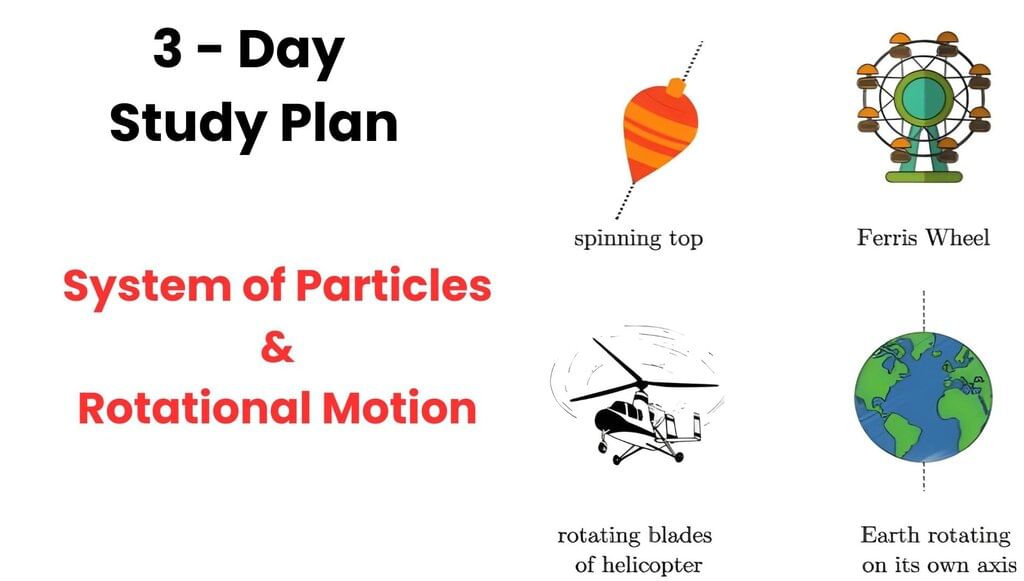JEE Exam > JEE Notes > Physics for JEE Main & Advanced > 3 Days Timetable: Rotational Motion (2025)
3 Days Timetable: Rotational Motion (2025) | Physics for JEE Main & Advanced PDF Download
Introduction
- Rotational Motion is a critical topic in physics that deals with the motion of objects rotating about an axis, covering concepts like moment of inertia, angular momentum, torque, and rolling motion.
- This 3-day study plan is designed for students preparing for exams like JEE, NEET, or board exams, utilizing resources from the provided course materials. The plan progresses from foundational concepts to advanced problem-solving and testing, ensuring a comprehensive understanding of rotational dynamics.
- By following this plan, you'll build a strong grasp of theory, apply concepts through practice, and refine your skills with targeted tests.

Study Plan
Day 1: Building Core Concepts
Begin with the fundamentals of rotational motion, focusing on key concepts like centre of mass, angular velocity, and moment of inertia. Use introductory resources to establish a solid foundation.
- Read: Centre of Mass (Text Doc) - Understand the concept of centre of mass.
- Watch: Center of Mass & Motion of the Center of Mass (Youtube) - Video explanation of centre of mass dynamics.
- Watch: Rotational Motion: Centre of Mass (Youtube) - Additional video on centre of mass.
- Read: Rotational Motion & Moment of Inertia (Text Doc) - Introduction to moment of inertia.
- Watch: Rotation Motion - Moment Of Inertia (Youtube) - Video on moment of inertia.
- Study: NCERT Solutions: System of Particles & Rotational Motion (Text Doc) - NCERT-based solutions for clarity.
- Review: Mnemonics: System of Particles and Rotational Motion (Text Doc) - Use mnemonics to memorize key concepts.
- Practice: Write down definitions and formulas for moment of inertia and angular velocity, and sketch diagrams for rotational systems.
Day 2: Advanced Concepts and Problem-Solving
Explore advanced topics like angular momentum, torque, rolling motion, and theorems of perpendicular and parallel axes. Focus on solved examples and shortcuts for efficient problem-solving.
- Read: Linear Momentum and Angular Momentum (Text Doc) - Study angular momentum concepts.
- Watch: Angular Momentum (Youtube) - Video explanation of angular momentum.
- Read: Rolling Motion (Text Doc) - Notes on rolling motion.
- Watch: Rolling Motion (Youtube) - Video on rolling motion dynamics.
- Read: Theorems of Perpendicular & Parallel Axis (Text Doc) - Understand axis theorems.
- Watch: Angular Velocity and its relation with Linear Velocity (Youtube) - Relationship between angular and linear velocity.
- Watch: Short Tricks for Revision: Moment of Inertia (Youtube) - Quick revision tricks.
- Study: DC Pandey Solutions: Mechanics of Rotational Motion (Text Doc) - Solved problems for practice.
- Practice: Solve 5-10 numerical problems on torque, angular momentum, and rolling motion.
Day 3: Revision, Practice, and Testing
Revise all topics, use visual aids for quick recall, solve previous year questions, and take tests to assess your preparation.
- Revise: Revision Notes: Rotational Motion (PDF Doc) - Concise revision notes.
- Review: Mind Map: Systems of particles and Rotational Motion (Text Doc) - Visual overview of concepts.
- View: PPT: System of Particles & Rotational Motion (PDF Doc) - Slide presentation for key points.
- Study: HC Verma Solutions: Chapter 9 - Centre of Mass, Linear Momentum, Collision (PDF Doc) - Solutions for centre of mass and collisions.
- Study: HC Verma Solutions: Chapter 10 - Rotational Mechanics (PDF Doc) - Solutions for rotational mechanics.
- PYQs: Rotational Motion: JEE Main Previous Year Questions (2021-2025) (PDF Doc) - Recent JEE questions.
- Test: Test: Moment of Inertia (Test) - Test on moment of inertia.
- Test: Test: Angular Momentum (Test) - Test on angular momentum.
- Test: Test: Rolling Motion (Test) - Test on rolling motion.
- Practice: Review test results and revisit weak areas using System of Particle and Rotational Motion in One Shot (Youtube) for a final overview.
Tips for Success
- Daily Practice: Solve numerical problems daily to master calculations for torque, moment of inertia, and angular momentum.
- Use Visuals: Leverage mind maps and PPTs to visualize complex rotational dynamics concepts.
- Time Management: Practice tests under timed conditions to improve speed and accuracy for exams.
- Clarify Doubts: Revisit YouTube videos or solved solutions (e.g., DC Pandey, HC Verma) for challenging topics like rolling motion.
- Stay Consistent: Follow the plan diligently and use previous year questions to align with exam patterns.
The document 3 Days Timetable: Rotational Motion (2025) | Physics for JEE Main & Advanced is a part of the JEE Course Physics for JEE Main & Advanced.
All you need of JEE at this link: JEE
|
268 videos|756 docs|171 tests
|
FAQs on 3 Days Timetable: Rotational Motion (2025) - Physics for JEE Main & Advanced
| 1. What is the significance of the center of mass in rotational motion? |  |
Ans. The center of mass is crucial in rotational motion as it simplifies the analysis of the motion of rigid bodies. It is the point where the mass of the body can be considered to be concentrated for the purpose of analyzing translational motion. In rotational motion, the dynamics of the system can be described more easily by studying the motion of the center of mass, which helps in determining the moment of inertia and angular momentum.
| 2. How do you calculate the moment of inertia for different shapes? |  |
Ans. The moment of inertia (I) can be calculated using the formula \( I = \int r^2 dm \), where \( r \) is the distance from the axis of rotation to the mass element \( dm \). For common shapes, there are standard formulas, such as \( I = \frac{1}{12} m L^2 \) for a rectangular plate about an axis through its center, and \( I = \frac{2}{5} m R^2 \) for a solid sphere about its center. These formulas take into account the mass distribution relative to the axis of rotation.
| 3. What is the difference between rolling motion and sliding motion? |  |
Ans. Rolling motion occurs when an object rotates about its axis while translating along a surface, such that there is no slipping between the object and the surface at the point of contact. In contrast, sliding motion involves the object moving over a surface without rotating or with some rotation but without the point of contact being stationary. Rolling motion is characterized by the relationship \( v = r\omega \), where \( v \) is the linear velocity, \( r \) is the radius, and \( \omega \) is the angular velocity, while sliding motion does not satisfy this relationship.
| 4. What are the conditions for equilibrium of a rigid body? |  |
Ans. For a rigid body to be in equilibrium, two main conditions must be satisfied: the sum of all forces acting on the body must be zero (\( \sum \vec{F} = 0 \)), and the sum of all torques acting about any point must also be zero (\( \sum \vec{\tau} = 0 \)). This ensures that there is no net force causing linear motion and no net torque causing rotational motion.
| 5. Can you explain the theorems of perpendicular and parallel axes in relation to moment of inertia? |  |
Ans. The perpendicular axis theorem states that for a planar body, the moment of inertia about an axis perpendicular to the plane is equal to the sum of the moments of inertia about two perpendicular axes lying in the plane and intersecting at a point. Mathematically, this is expressed as \( I_z = I_x + I_y \). The parallel axis theorem states that the moment of inertia about any axis parallel to an axis through the center of mass is given by \( I = I_{cm} + md^2 \), where \( I_{cm} \) is the moment of inertia about the center of mass axis, \( m \) is the mass, and \( d \) is the distance between the two axes.
Related Searches





















